Dunhuang’s Buddhist art comes to Asian Civilisations Museum in biggest South-east Asia show
Sign up now: Get ST's newsletters delivered to your inbox

At the signing of the memorandum of understanding were (from left) Asian Civilisations Museum (ACM) deputy director Chun Boon Beng; ACM director Clement Onn; Dr Zhang Yuanlin, deputy director of Dunhuang Academy; and Ms Wang Huihui, deputy head of Exhibition Centre for the Conservation and Research of Dunhuang Cave Relics, Dunhuang Academy.
PHOTO: ASIAN CIVILISATIONS MUSEUM
Follow topic:
SINGAPORE – Buddhist art treasures from the Unesco World Heritage Site of the Dunhuang Mogao Caves will be shown at the Asian Civilisations Museum (ACM) in the second half of 2026.
The first major exhibition in South-east Asia dedicated to Dunhuang is a collaboration between the museum and the Dunhuang Academy, the institution which oversees the site in Gansu, China. The partnership was formalised by the signing of a memorandum of understanding at ACM on Oct 24.
Dr Zhang Yuanlin, deputy director of Dunhuang Academy, notes that ACM has successfully collaborated with leading Chinese cultural heritage institutions such as the Palace Museum and Shaanxi History Museum in recent years.
He adds that ACM and the academy have a shared mission of promoting dialogue between civilisations.
“Both institutions have a natural resonance in our thematic focus, embodying timeless similarities in cross-cultural and cross-religious inclusivity. The Buddhist art, social life and cultural exchanges depicted in the Dunhuang caves along the land-based Silk Road complement ACM’s collections, jointly piecing together a more complete map of civilisational exchange along the Silk Roads.”
He notes that the two institutions connected following a 2024 digital exhibition. “The successful presentation of Dunhuang Is Not Far – Digital Dunhuang Exhibition In Singapore built a bridge of mutual understanding between the people of both countries, which established a foundation of trust and a cooperation model. This deeper partnership represents an evolution, from ‘digital presentation’ to ‘civilisational dialogue’, infusing China-Singapore cultural exchange with greater significance.”
Mr Clement Onn, director of ACM and the Peranakan Museum, says the museum began planning a Buddhist art exhibition in 2023.
“Dunhuang and the Mogao Caves were chosen because of their pivotal role in the spread of Buddhism across Asia, inspiring and influenced by myriad cultures and artistic expressions. Dunhuang was also an important cosmopolitan trading city along the Silk Road, drawing parallels with Singapore’s role today as a multicultural port city,” he adds.
The famed Mogao caves are a network of 492 cells carved into cliffs above the Dachuan River in the Dunhuang oasis in China’s Gansu province. Built in AD366, the caves represent the greatest achievements of Buddhist art spanning 1,000 years of cultural heritage.
The caves’ strategic position along the historic Silk Road also means this rich storehouse offers insights into the thriving cultural and trade exchanges of the ancient world from the 4th to the 14th centuries.
Besides treasures from the caves, the exhibition will also present full-scale reproductions of grottoes as well as immersive digital experiences that bring the caves and their paintings to life.
Mr Onn adds: “The exhibition examines Dunhuang as a vibrant trading oasis on the Silk Road, its magnificent Buddhist art, its diverse people and its enduring cultural legacy.”


